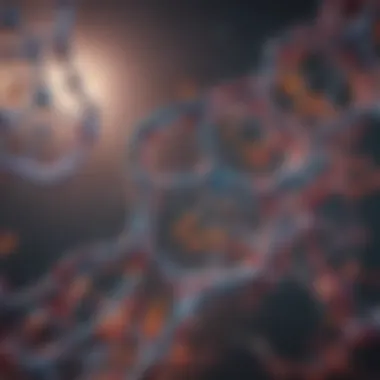Innovations in RNA Testing Techniques for Modern Science


Intro
RNA testing methodologies have taken center stage in the realms of diagnostics, therapeutics, and groundbreaking research. As we dive into the intriguing world of RNA, it becomes clear that the evolution of testing techniques is not just a scientific curiosity, but rather a foundation for modern medicine. With the ability to unlock insights about diseases and their mechanisms, RNA testing opens up new possibilities for personalized therapies and advancements in understanding complex biological systems.
The significance of RNA tests is broad. They serve critical roles in detecting infections, understanding genetic disorders, and even in cancer research, where they might tell a story of the disease’s progression. With the pace of advancements in technology, staying abreast of these methodologies is essential.
This article aims to shed light on these emerging RNA testing strategies, focusing on:*
- The key advancements that are shaping the future
- The methodologies currently in use
- Challenges researchers face
- Potential future trajectories for RNA testing in science and medicine
Research Overview
Summary of Key Findings
Recent developments in RNA testing reflect a growing recognition of its potential. It has been found that RNA can serve as easily accessible biomarkers, providing a window into cellular health. Studies suggest that high-throughput sequencing has expanded the palette of RNA tests available, offering unprecedented sensitivity and specificity.
Moreover, the discovery of new RNA molecules—like long non-coding RNAs—has unveiled their significant impact in gene regulation and disease mechanisms. This highlights that methods such as RNA-Seq are not just tools for quantification, but pivotal in understanding the underlying biology of various conditions.
Research Objectives and Hypotheses
The primary objective of the recent studies is to define how various RNA testing methodologies can be systematically applied to enhance disease diagnosis and prognosis. There are hypotheses that:
- Different types of RNA molecules correlate with specific disease states, and thus can serve as indicators for diagnosing illnesses.
- Novel methodologies will improve the sensitivity of RNA tests, ultimately allowing better early detection of diseases.
Methodology
Study Design and Approach
In exploring RNA testing innovations, the studies typically adopt both quantitative and qualitative designs. A layered approach is utilized:
- Comparative studies assess the efficacy of existing methods versus new ones.
- Longitudinal studies track how RNA test results correlate with disease progression over time.
Additionally, interdisciplinary collaborations among molecular biologists, bioinformaticians, and clinicians foster a robust research environment that encourages diverse perspectives in advancing RNA methodologies.
Data Collection Techniques
The data collection process is central to the validity of RNA testing research. It often includes:
- Sampling Techniques: Specimens of blood, tissue, or saliva are collected to analyze RNA content.
- RNA Extraction: Various kits or protocols are followed to ensure high-purity RNA extraction for subsequent analysis.
- Sequencing: Techniques like Illumina sequencing or nanopore sequencing are employed to gain a deep insight into RNA profiles.
Prologue to RNA Testing
RNA testing has swiftly become a cornerstone within the fields of molecular biology, clinical diagnostics, and therapeutic research. As we delve into this multi-faceted subject, it’s essential to grasp what RNA testing entails and why it holds such significance. In essence, RNA testing is the process of analyzing ribonucleic acid to glean insights that can guide diagnostics, research, and treatment decisions. This article aims to illuminate these dynamics, underscoring their critical role in modern science.
Understanding RNA
Ribonucleic acid, or RNA as it’s quite commonly known, serves as a fundamental player in the transfer of genetic information. Unlike DNA, RNA is typically single-stranded and comes in various forms, including messenger RNA (mRNA), which transmits genetic instructions from DNA to the cellular machinery, and ribosomal RNA (rRNA), which is a structural component of ribosomes. These different types of RNA work harmoniously to carry out one of life's most vital functions—protein synthesis.
To relate this complexity in simpler terms, think of RNA as the middleman in a cooking recipe. If DNA is the recipe itself, then RNA acts as the messenger that takes the instructions to the kitchen, making sure the chef knows exactly what to do next. An understanding of this relationship is crucial, as it lays the groundwork for recognizing the implications of testing RNA in a variety of contexts.
Importance of RNA in Biological Systems
The importance of RNA in biological systems extends beyond mere protein construction. RNA molecules don’t just play passive roles; they are involved in the regulation of gene expression, ensuring that genes are turned on or off at appropriate times. This regulatory mechanism is pivotal in orchestrating everything from cellular responses to environmental stimuli to complex developmental processes.


Moreover, the role of RNA is amplified when one considers its implications in health and disease. Certain RNA molecules can serve as biomarkers for various diseases; for example, specific patterns of mRNA expression can indicate the presence of cancer or other serious conditions. As such, exploring RNA through testing methods opens a plethora of possibilities for early disease detection and the development of targeted therapies.
"Advancements in RNA testing methodologies not only improve diagnostic capabilities but also pave new avenues for personalized medicine, highlighting the intertwined nature of RNA biology and clinical practices."
Overview of RNA Testing Methods
In the realm of molecular biology, RNA testing methods are pivotal for both fundamental research and clinical applications. Their importance lies not only in diagnosing diseases but also in understanding complex biological processes. RNA, being a crucial player in protein synthesis and gene expression, necessitates precise testing methodologies to grasp its dynamics in various contexts. This section delves into several prominent RNA testing techniques—each with unique advantages and potential drawbacks—providing a comprehensive overview that helps to elucidate their respective roles in the scientific landscape.
Polymerase Chain Reaction (PCR)
Polymerase Chain Reaction, or PCR, is arguably the cornerstone of molecular biology techniques concerning nucleic acids. This method amplifies specific RNA segments, allowing for their subsequent analysis. The power of PCR lies in its ability to generate millions of copies of a particular sequence from just a few strands of RNA. This is particularly beneficial when starting material is limited, such as in clinical samples or single cells.
PCR is renowned for its speed and efficiency, but it isn’t without limitations. For instance, contamination can lead to erroneous results, which must be carefully monitored. Furthermore, designing specific primers is crucial to avoid non-specific amplifications, which can muddy the clarity of results. Though PCR is robust, its application demands meticulous attention to detail—a slight oversight could potentially derail the whole experiment.
Reverse Transcription PCR
Reverse Transcription PCR (RT-PCR) takes the traditional PCR one step further by reversing RNA into complementary DNA (cDNA) before amplification. This process is vital for quantifying gene expression levels in various tissues or cells. By harnessing the specificity of primers, researchers can pinpoint the abundance of specific mRNAs in a sample, offering insights into cellular response under different conditions.
While RT-PCR is quite effective, one must consider the inherent challenge of RNA stability. RNA is more prone to degradation than DNA, making sample handling a critical factor. Researchers often use RNase inhibitors to protect RNA from enzymatic degradation, ensuring that the sample remains intact until amplification occurs. This technique has become essential in studies involving gene expression analysis, therapeutic targets, and diagnostic markers.
Next-Generation Sequencing
Next-Generation Sequencing (NGS) has revolutionized the landscape of RNA testing by enabling whole-transcriptome analysis. Unlike traditional methods that focus on specific regions, NGS provides comprehensive data on all RNA molecules present in a sample. It’s a game changer in epidemiological studies, allowing for the profiling of gene expression patterns in healthy versus diseased states.
The sheer volume of data NGS generates is both a blessing and a curse. It offers unprecedented depth of information, yet it demands significant computational resources and expertise for analysis. Moreover, the potential for sequencing artifacts exists, which researchers must navigate through quality control measures. As the technology continues to evolve, NGS’s ability to reveal novel transcripts and biomarkers is poised to enhance our understanding of disease mechanisms further.
Microarray Analysis
Microarray Analysis serves as a parallel approach to investigate gene expression. This method allows researchers to measure the expression levels of thousands of genes simultaneously by hybridizing labeled RNA (or cDNA) to a chip containing oligonucleotides for each gene of interest. The ability to conduct high-throughput screening is one of its standout features, making it possible to analyze expression across a broad spectrum of genes.
However, while microarray analysis can provide rich datasets, it tends to lack the resolution and sensitivity of NGS. It also requires prior knowledge of the genes being studied, which can be limiting when exploring unknown or less-characterized transcripts. Additionally, the interpretation of microarray data involves various statistical challenges that can affect the reliability of the results. Despite these limitations, it remains a valuable tool in various research areas, particularly in cancer genomics and toxicogenomics.
"Each RNA testing method carries its own strengths and weaknesses. A thoughtful approach in selecting the appropriate technique is crucial for achieving reliable results."
Applications of RNA Testing
The landscape of RNA testing has evolved dramatically over the past few decades. As we delve into the applications of RNA testing, it's essential to note how this type of analysis serves as a cornerstone not only in research but also in practical medical applications. The capacity of RNA testing to provide insights into various biological processes can be a game changer, aiding in the understanding and management of numerous health conditions.
Clinical Diagnostics
Clinical diagnostics represent one of the most significant applications of RNA testing. The ability to analyze RNA allows for the detection of diseases at their molecular level, often long before traditional methods could ever pick up on symptoms. This early detection can lead to timely interventions, improving patient outcomes.
For instance, reverse transcription PCR is frequently employed to identify specific viral RNA sequences, enabling the diagnosis of infections such as HIV and hepatitis. Moreover, RNA sequencing offers a comprehensive view, facilitating the identification of genetic mutations that might predispose individuals to specific diseases. Such methodologies underscore the precision and accuracy that RNA testing brings to the clinical diagnostics table.
Cancer Biomarkers
When it comes to cancer detection, RNA testing is invaluable. Cancerous cells often exhibit unique RNA profiles that can act as biomarkers, providing insights into tumor types and stages. For example, non-coding RNAs are frequently implicated in cancer development and progression. Researchers are harnessing these molecules as potential diagnostic tools to detect cancers like breast or lung cancer at an earlier stage.
"The use of RNA biomarkers in oncology could significantly shift how we approach cancer treatment, leading to more personalized treatments tailored to the molecular signature of a patient's tumor."
Furthermore, RNA testing can help monitor treatment responses, giving oncologists vital information about whether a specific therapy is effective or if adjustments are necessary. Through analyzing circulating tumor RNA, it enables real-time assessment without requiring invasive biopsies.
Viral Detection
Viral detection is another critical area where RNA testing shines. As we have seen recently with the COVID-19 pandemic, RT-PCR testing became the gold standard for confirming infections. The assay targets specific viral RNA sequences, enabling rapid and accurate diagnosis. This method was not only essential in managing public health efforts but also highlighted the ability of RNA testing to adapt to emergent viral threats.


Other viruses like Zika and influenza are also diagnosed through similar RNA testing methodologies. By utilizing these tests, healthcare professionals can implement targeted interventions and are better equipped to halt outbreaks before they escalate.
Genetic Disease Testing
Genetic diseases often stem from mutations in DNA, but discovering these conditions can rely heavily on RNA testing. With the advent of technologies like single-cell RNA sequencing, scientists can explore the expression of genes in real-time, revealing how genetic disorders manifest at a cellular level.
A prime example includes spinal muscular atrophy, where RNA testing can identify faulty gene expressions that lead to symptoms. Additionally, RNA testing can be used for carrier screening, allowing prospective parents to assess the likelihood of passing certain genetic conditions to their offspring. This application not only informs family planning decisions but has far-reaching implications for managing genetic disorders in the population.
In summary, the applications of RNA testing encapsulate a wide range of diagnostics and therapeutics. Each application, from clinical diagnostics to genetic testing, highlights how vital RNA is in bridging gaps in understanding complex biological systems and mechanisms.
Challenges in RNA Testing
Stability and Degradation Issues
One of the significant obstacles in RNA testing is the stability and degradation of RNA molecules. RNA is notoriously sensitive and can degrade rapidly under less-than-ideal conditions. Several factors contribute to this fragility, such as temperature fluctuations, enzyme activity, and the presence of contaminants. These stability issues can introduce variability in test results, leading to unreliable data and misinterpretation of outcomes.
To mitigate these concerns, a rigorous approach must be taken during sample collection and handling. For instance, using specialized stabilizing reagents can help prolong the lifespan of RNA in the sample, allowing for accurate testing even days after collection. Additionally, optimizing storage conditions—keeping samples on ice or at regulated temperatures—can significantly reduce degradation risk. A thorough understanding of RNA's behavior in different environments is vital for researchers and clinicians alike.
Technical Limitations
Despite immense progress made in RNA testing technologies, technical limitations still loom large. Different methods come with their own sets of restrictions, which can impact sensitivity, specificity, and even the types of RNA that can be analyzed. For example, while next-generation sequencing provides in-depth insights, it can require substantial computational resources and expertise that aren't universally available.
Moreover, variations in sample quality can lead to inconsistencies across tests. When working with heterogeneous biological samples, the presence of inhibitors or other biomolecules can skew results, making it challenging to ensure reproducibility. This inconsistency raises questions regarding the applicability of findings in diverse settings, particularly in clinical environments where stakes are high.
Regulatory Hurdles
Navigating the regulatory landscape for RNA testing can feel like threading a needle in a haystack. Regulatory agencies like the FDA impose strict guidelines to ensure that testing methodologies are safe, accurate, and effective. However, this can delay the introduction of innovative techniques into clinical settings.
Researchers exploring groundbreaking RNA methodologies often find themselves entangled in a web of compliance requirements that can stretch timelines and drain resources. While regulations are undoubtedly necessary to protect patient safety, the process can stifle innovation and slow down the progression of potentially life-saving tests.
"Understanding the regulatory landscape is as crucial as mastering the methodologies themselves; both are integral to the success of RNA testing innovations."
In summary, while advancements in RNA testing methodologies hold great promise, the challenges posed by stability and degradation issues, technical limitations, and regulatory hurdles cannot be underestimated. Each of these elements plays a pivotal role in shaping the reliability and applicability of RNA tests. By addressing these challenges, the field can look forward to unlocking new potentials and facilitating the broader utilization of RNA testing in various domains.
Innovative Techniques in RNA Testing
Innovative techniques in RNA testing are at the forefront of molecular biology, allowing for more precise and nuanced insight into the RNA landscape. As methodologies evolve, they're not just enhancing our understanding of genetic material but also revolutionizing diagnostics and therapeutic approaches. These innovative techniques offer benefits like higher sensitivity, adaptability to various research needs, and greater resolution in data analysis.
Digital PCR
Digital PCR (dPCR) marks a significant leap from traditional PCR by partitioning the reaction into thousands of individual segments, allowing for more accurate quantification of RNA. This method is particularly useful in scenarios where low levels of RNA need detection. It breaks down the sample into smaller parts, providing a higher resolution than conventional PCR. This avoids problems with threshold settings that can skew results.
Benefits of dPCR include:
- Enhanced Precision: By analyzing several small reactions, it minimizes variability in measurements.
- Improved Sensitivity: Detects rare transcripts that could be missed in standard methods.
- Less Complex Data Interpretation: Simplifies the process of measuring absolute quantities of RNA in a sample.
Researchers leveraging Digital PCR find it especially helpful in cancer research, where detecting minimal residual disease can be crucial for patient management. Overall, this digitized approach is reshaping how scientists approach RNA quantification and analysis.
Single-Cell RNA Sequencing
Single-Cell RNA Sequencing (scRNA-seq) represents a groundbreaking method that enables researchers to study gene expression at the level of individual cells. Unlike bulk RNA sequencing, which averages signals from many cells, scRNA-seq captures the unique transcriptional landscape of each cell, delivering a nuanced perspective of cellular functions.
The importance of this technique lies in its ability to reveal:


- Heterogeneity in Cell Populations: This is vital for understanding complex tissues or tumors where different cells may respond differently to treatments.
- Cellular Developmental Trajectories: By analyzing gene expression patterns over time in the same cells, one can track developmental changes or responses to stimuli.
- Identification of Rare Cell Types: ScRNA-seq helps uncover rare populations that might play critical roles in development or disease, but would be lost in bulk measurements.
This advancement is changing the game not only in cancer studies but also in immunology and developmental biology, where recognizing subtleties at the single-cell level leads to a better grasp of mechanisms that govern cellular behavior.
RNA-Seq for Transcriptome Profiling
RNA-Sequencing (RNA-Seq) has become a cornerstone in transcriptome profiling, enabling comprehensive analysis of RNA transcripts through next-generation sequencing technologies. This method allows for the detailed quantification of RNA, helping researchers identify not just the amount of various RNA species but also splice variants and gene fusions.
Major Advantages of RNA-Seq include:
- Comprehensive Analysis: Unlike microarrays that are limited to pre-defined probes, RNA-Seq captures all RNA species, providing a more complete picture of the transcriptome.
- Dynamic Range and Sensitivity: RNA-Seq can quantify RNA levels across a broad range, making it easier to study both lowly and highly expressed genes.
- Discovering Novel Transcripts: Because RNA-Seq does not rely on pre-existing knowledge of the genome, it can identify previously unrecognized transcripts, be they coding or non-coding.
By harnessing RNA-Seq, scientists are uncovering insights into gene regulation, alternative splicing, and the roles of non-coding RNAs in various diseases and biological processes. This technique is an integral part of modern genomics and is shaping research into a wide array of biological questions.
Innovations in RNA testing methodologies not only refine our understanding of the molecular mechanisms but they also pave the way for personalized medicine and targeted therapeutic strategies.
Future Directions in RNA Testing
The field of RNA testing is rapidly evolving, with several pathways emerging that promise to revolutionize how we approach diagnostics, treatment, and environmental science. The significance of these advancements cannot be overstated, especially in an age where precision and personalization are paramount in both health care and environmental stewardship. Understanding the future directions in RNA testing helps pave the way for innovations that can cater to complex, multifaceted biological and ecological questions.
Integration with Artificial Intelligence
Artificial intelligence is making waves in various fields, and RNA testing is no exception. By merging AI algorithms with RNA sequencing data, researchers can unearth patterns and insights that would otherwise remain buried in vast datasets. This combination allows for faster processing and more accurate interpretation of results. Not only that, but AI can also assist in predictive modeling, giving us a clearer view into how certain RNA profiles may impact individual health or response to therapies.
Moreover, using AI techniques like machine learning can enhance the accuracy of RNA-based diagnostics. For example, algorithms can help distinguish between benign and malignant cases based on RNA expression levels, thereby eliminating some guesswork clinicians face today.
Personalized Medicine Advancements
Personalized medicine leverages an individual’s genetic makeup to tailor treatments. RNA testing plays a critical role in this by helping to identify gene expression patterns that correlate with efficacies and side effects of medications. For instance, insights gained from RNA profiles can guide oncologists in selecting specific therapies for cancer patients based on their tumor's unique characteristics.
A practical example of this could involve treatments for breast cancer, where RNA testing can reveal which patients are likely to benefit from hormone therapy versus chemotherapy. As more clinicians embrace RNA analysis, we can expect treatments to become not only more effective but also safer, minimizing adverse effects by providing tailored care.
Environmental and Ecological Applications
RNA testing isn't limited to medical fields; its applications extend to environmental and ecological contexts as well. Scientists are starting to utilize RNA methods to monitor ecosystem health, assess biodiversity, and even track the impact of climate change on specific species. For example, mRNA profiles can indicate how organisms respond to environmental stressors, helping conservationists make informed decisions about habitat protection and restoration.
Moreover, RNA sequencing can assist in understanding microbial communities in various environments, such as oceans, soils, and forests. This understanding can lead to insights on nutrient cycling and ecosystem functions—key areas in biodiversity conservation.
In summary, as RNA testing methodologies advance, integrating cutting-edge technology like AI, personalizing treatment options, and applying these insights to ecological sciences can yield a compounding impact in both health care and environmental preservation. Embracing these directions will be pivotal in shaping a healthier world and sustainable practices.
End
In summing up our exploration of RNA testing methodologies, it's essential to emphasize the pivotal role RNA plays in the fabric of life and its remarkable potential in medical and scientific fields. As we've detailed, advances in RNA testing are not merely a trend but a significant leap forward in our understanding and capabilities in diagnostics and treatment strategies. These methodologies hold the keys to deciphering genetic codes, identifying diseases, and personalizing healthcare.
Recap of RNA Testing Significance
The significance of RNA testing lies in its ability to provide real-time insights into cellular processes. Unlike DNA, which remains relatively stable, RNA levels fluctuate in response to various stimuli, revealing a snapshot of cellular activity. This dynamic nature makes RNA testing invaluable in numerous fields. For instance, in clinical diagnostics, it's used to accurately diagnose diseases through gene expression profiles, potentially catching illnesses at their infancy, which can greatly improve patient outcomes.
- Accessibility: As techniques improve, RNA testing is becoming more accessible, making it an integral part of routine medical practices.
- Diverse Applications: From cancer research to infectious disease detection, the breadth of RNA applications illustrates its far-reaching impact.
- Research Advancements: In the realm of research, RNA methodologies provide vital data that can fuel further discoveries, ultimately leading to breakthroughs in both understanding disease mechanisms and developing new therapies.
This significance cannot be overstated, as it paves the way for future innovations in healthcare and research, ensuring that RNA testing remains a cornerstone of modern science.
Impact on Future Research and Healthcare
Looking ahead, the implications of RNA testing methodologies stretch far beyond their current uses. The integration of advanced technologies, such as machine learning and artificial intelligence, is set to revolutionize how we analyze RNA data, allowing for more accurate predictions and personalized treatments. For example, artificial intelligence could identify patterns in gene expression data that elude even the most experienced researchers.
The healthcare landscape is also shifting. Personalized medicine is on the rise, and RNA testing will play an instrumental role in tailoring treatments to individual patients based on their specific genetic makeup.
Moreover, the potential for RNA technologies in environmental and ecological applications is becoming clearer. For instance, monitoring RNA from environmental samples can help in understanding the health of ecosystems and the impact of pollutants.
"The future of RNA testing is bright, promising breakthroughs that can alter our understanding of both human health and the environment."















